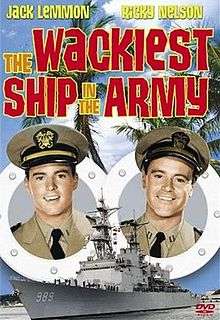The Wackiest Ship in the Army (film)
| The Wackiest Ship in the Army | |
|---|---|
 The DVD Movie Cover | |
| Directed by | Richard Murphy |
| Produced by | Fred Kohlmar |
| Written by |
Richard Murphy Herbert Margolis William Raynor |
| Based on |
Big Fella Wash-Wash 1956 story in Argosy by Herbert Carlson |
| Starring |
Jack Lemmon Ricky Nelson |
| Music by | George Duning |
| Cinematography | Charles Lawton Jr. |
| Edited by | Charles Nelson |
| Distributed by | Columbia Pictures |
Release dates | December 20, 1960 |
Running time | 99 min. |
| Country | United States |
| Language | English |
The Wackiest Ship in the Army is a 1961 Eastmancolor CinemaScope comedy-drama war film starring Jack Lemmon, Ricky Nelson, and Chips Rafferty. It was filmed at Pearl Harbor and Kauai.
Plot summary
During World War II, Lt. Rip Crandall (Jack Lemmon), an expert yachtsman in civilian life, now based at Townsville, Queensland, Australia, is surprised to be assigned command of a sailing ship, the USS Echo. The only crew member who knows how to work a ship with sails is eager young Ensign Tommy Hanson (Ricky Nelson), who cost Crandall a yacht race with a mistake before the war.
Crandall tries to refuse this dubious command, but Hanson and Crandall's former sailing buddy Lt. Commander Vandewater (John Lund) wear down his resistance. Vandewater points out Crandall's poor fitness report and advises that, if he doesn't take this command, he'll never get another. Hanson takes Crandall out drinking with some of the men so he'll feel guilty about abandoning them.
The Echo barely makes it out of the harbor, sailing straight into a storm. When it arrives in Port Moresby, New Guinea, Crandall is supposed to train a replacement to deliver a coastwatcher named Patterson (Chips Rafferty) to a location only a shallow-draft vessel can reach. However, the replacement (Richard Anderson) strikes Crandall as stiff-necked and unqualified to handle this kind of mission, so he takes the ship out under his own command to deliver Patterson.
Making the crossing in a not-very-convincing disguise as a native trading vessel, Crandall and his crew are spotted and photographed by an enemy plane. While they are delivering their passenger, a Japanese force from a passing war fleet boards the scow and captures the landing party when they return.
Crandall manages to rally his men to take the ship back. He is then faced with the decision of whether to radio a warning about the fleet, even though that will give away their position to guns on shore. He sends the warning and abandons ship as the guns open fire on the Echo and destroy her.
The crew survives to be rescued, and Crandall is given command of a modern destroyer whilst Hanson gains command of a sub chaser for their role in helping to win the Battle of the Bismarck Sea.
Cast
- Jack Lemmon as Lt. Rip Crandell
- Ricky Nelson as Ens. Tommy J. Hanson
- John Lund as Lt. Cmdr. Wilbur F. Vandewater
- Chips Rafferty as Patterson (coast watcher)
- Tom Tully as Capt. McClung
- Joby Baker as Josh Davidson
- Mike Kellin as Chief Petty Officer
- Warren Berlinger as Radioman 2nd Class A.J. 'Sparks' Sparks
- Patricia Driscoll as Maggie, Lt. Cmdr. Vanderwater's secretary
- Richard Anderson as Lt. Dennis M. Foster
- Alvy Moore as Seaman J. Johnson
- George Shibata as Captain Shigetsu
Production notes
The USS Echo was based on the real-life USS Echo (IX-95), a 40-year-old twin-masted scow (flat-bottomed schooner) that was transferred from the New Zealand government to the US Navy in 1942, and returned to the New Zealand government in 1944.
Columbia Pictures acquired the rights to a story in the July 1956 issue of Argosy titled Big Fella Wash Wash, inspired by reminisces from former Echo skipper Meredith "Rip" Riddle.[1] The story was advertised on the cover of the magazine as "The Wackiest Ship in the Army", because the naval vessel had been under Army command while in port, and Columbia used that title when purchasing the story in 1957. The movie never explained any connection between the ship and the Army, puzzling some viewers. (The later TV series spelled out the link.)
The director and writer of the film was Richard Murphy, who had written the script for the 1951 film You're in the Navy Now. The film was originally developed for Ernie Kovacs in the lead role, with Lemmon as the ensign. But at production time Kovacs was unavailable, and Lemmon was considered too old-looking for an ensign. So Lemmon got the lead role and popular actor/singer Ricky Nelson the supporting role.
Though acquired before Operation Petticoat, this film was not released until after that film. The U.S. Navy provided extensive cooperation allowing the producers to film at Pearl Harbor.[2]
TV series
The film inspired the 1965 TV series of the same name.
Notes
- ↑ http://the.honoluluadvertiser.com/article/2007/Dec/11/ln/hawaii712110331.html
- ↑ pp. 204-208 Erickson, Hal Military Comedy Films: A Critical Survey and Filmography of Hollywood Releases Since 1918 McFarland, 7 Aug 2012
External links
- The Wackiest Ship in the Army at the Internet Movie Database
- The Wackiest Ship in the Army at AllMovie
- The Wackiest Ship in the Army at the TCM Movie Database
- The Wackiest Ship in the Army at the American Film Institute Catalog